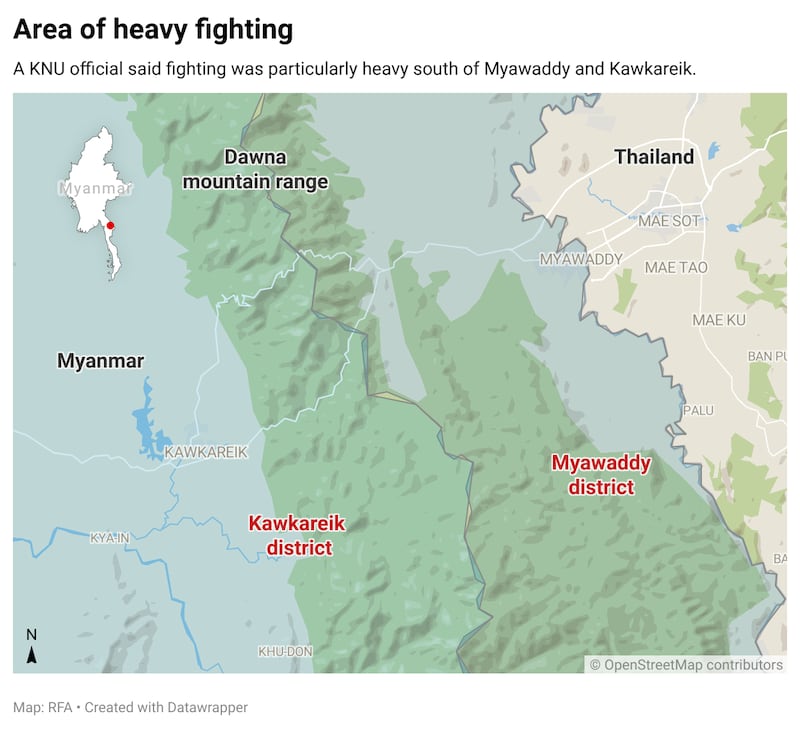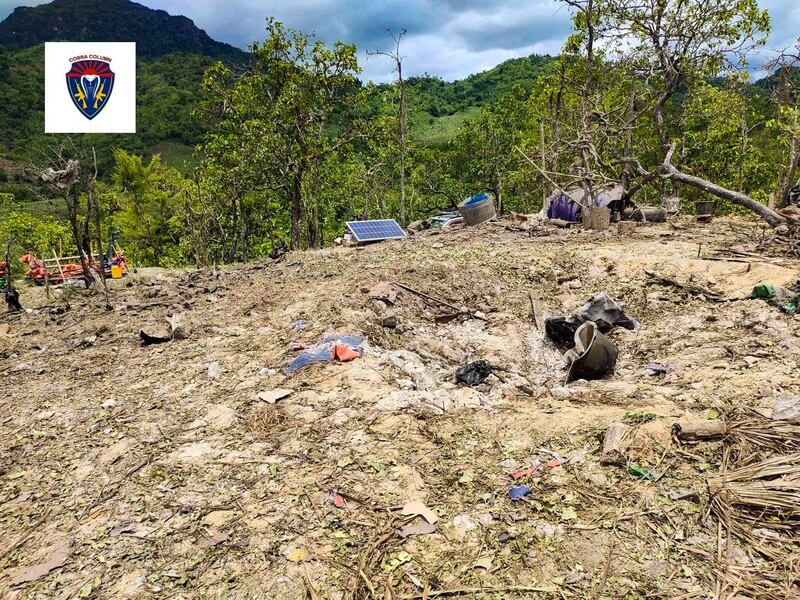Karen National Union forces have killed nearly 50 soldiers from Myanmar’s military in weeks of heavy fighting in an area near the Thai border that, despite a major junta offensive, remains controlled by the KNU.
There have been 33 clashes between the KNU and the junta since the military launched a major offensive in the area in early August. Despite heavy bombardment, the KNU says it has largely deflected the attacks with two killed and 16 wounded compared to 48 junta troops killed and 80 wounded, a KNU statement on Wednesday said.
RFA has not been able to confirm the casualty numbers. The KNU also said that the fighting had forced a number of residents in the Myawaddy and Kawkareik areas to flee and that one civilian had been killed.
According to the statement, Kawkareik district, known in the Karen language as Dooplaya district, has been the site of fighting between the KNU and 18 junta battalions, 17 of which were under the 11th, 22nd, and 44th divisions of the Border Guard Force.
Junta troops have focused their attacks on the eastern side of the Dawna mountain range, Padoh Saw Liston, the secretary of the district, told RFA’s Burmese Service.
“The attacks were primarily in the south of Myawaddy and south of Kawkareik. Clashes have been going on continuously since December 2021,” he said. “They are focusing on the area in the eastern part of Dawna Range. I don't know why they are targeting the area. There were many casualties during each battle.”

Fighting in Dooplaya became more intense after a change in the leadership of the Southeast Regional Military Command, Padoh Saw Liston said. Maj. Gen. Myat Thet Oo, who had led the northern command in Kachin, switched roles with Maj. Gen. Ko Ko Maung, who had been commander of the southeast command in Karen, the Irrawaddy news service reported on Aug. 20.
The six battalions under the Karen National Liberation Army’s 6th Brigade and a defensive force called the Cobra Column are fighting against the military offensive.
Junta soldiers have used artillery rockets, howitzer guns and airstrikes in the fighting, Myothura Ko Ko, the information officer of the Cobra Column, told RFA. The column is defending the Thone Dat Kway area on the Myawaddy-Waw Lay Road.
“Fighting has become more intense in the last seven days. The junta army was using more force than before,” he said.
“In addition to having superior numbers, they have opened many fronts, and a large number of heavy weapons are being used for covering fire. In the aerial bombardments, they are using 500-pound bombs,” Myothura Ko Ko said. “They also use cluster bombs. A lot of airstrikes were launched in the same place and the fighting was fierce.”
RFA tried to contact junta spokesman Maj. Gen. Zaw Min Tun by phone, but he did not answer.

Pado Saw Liston said the KNU suffered fewer casualties due to their strong morale, familiarity with the territory, and ability to use guerilla warfare.
Civilians had to flee to the banks of the Thaung Yin (Moei) River and are running low on food, a refugee told RFA.
“We have had to run from place to place since the battles began. We can only run on foot. We don’t have cars or motorcycles to flee to safety. We ran into the rain forests and slipped in the mud,” the refugee said.
“Adults have to be carried by others. We were all running away in fear ... right up to the river bank [of Thaung Yin]. We sleep on the shore. We eat by the shore. Some people do not even have any food.”
According to KNU's statement, at least 90,291 people have been displaced due to the fighting in the area controlled by the KNU’s 6th Brigade that intensified in December 2021.
The sources in this report declined to name specific locations for security reasons.
Translated by Khin Maung Nyane. Written in English by Eugene Whong.
